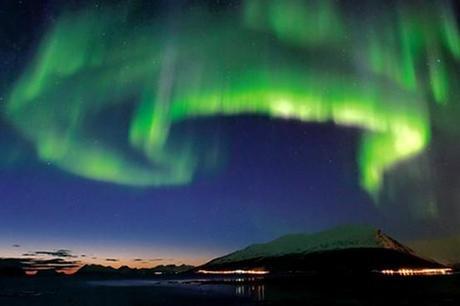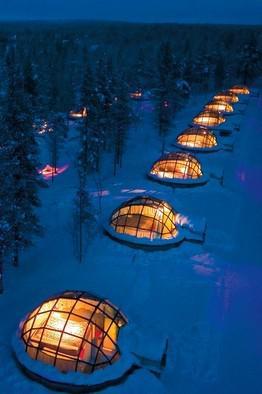
Source: online.wsj.com via Vanessa on Pinterest
I usually don't give much thought to the Northern Lights, I just view them as one of nature's mystical wonders meant to be admired. However, when I was out to dinner with my friend B last night, she spoke so enthusiastically about wanting to go see them. She was adament about booking a flight anywhere that she could see them--Finland, Norway, Sweden, though Alaska seemed like the easiest and most economical option. When I asked what was so great about it, she simply replied, "I've always wanted go!" It doesn't hurt that this year, the Northern Lights are expected to be especially vivid thanks to increased solar activity. Now through the end of March is the best time to see the lights, according to experts, which only adds to her eagerness to get out of the city. Much to her chagrin, her job as an accountant makes it near impossible for her to go anywhere before April--thank you, busy season.
But for those of you who actually can make it up north to see the show, it certainly is a spectacular site.
Break for a science lesson:
An aurora is a natural light display that occurs at high latitude regions, caused by energetic charged particles colliding with atoms in the thermosphere. The charged particles are generated in the magnetosphere and are directed by the Earth's magnetic field, drawing them into the atmosphere. Most aurorae occur in the auroral zone. There are a couple kinds of aurora: the diffuse and the discrete. Diffuse are featureless, usually a glow in the sky that is barely visible. Discrete are sharply defined and are usually only seen in the night sky. These are the ones that show the magnetic field lines or curtain-like structures, and can change within seconds or remain unchanged for hours.
Obviously, there is a lot more advanced science behind this, but that's the basic overview. All you really need to know is that these particles provide us with a stunning light show that eclipses anything we could create through technology.
So, where can you go to see the Northern Lights?
Some of the best places to go are in Scandinavia.
Norway: The lights can be seen from all over the country, but the best place is above the Arctic Circle in the northern region. The belt hits the Lofoten Islands in the north and follows the coast up to the North Cape, so anywhere along this strip is prime for viewing.
And while you're waiting for the lights--since there is no guarantee of when they will appear--it's a good idea to take part in some kind of activity or tour. Hurtigruten is a cruise company that offers six- to 12-day sailings along the coast. Guests can relax on the deck, or in their spacious cabins, enjoying great Scandinavian food and champagne. Each room has an aurora borealis alarm clock to notify passengers when the lights appear.
If you prefer to stay on dry land, why not try a snowmobiling or dog sledding excursion. There are plenty of guided tour operators for both, so just select one and get going!

Source: online.wsj.com via Vanessa on Pinterest
Finland: Even though the aurora borealis is elusive sometime, it is visible about 200 nights a year in Finland. For unhindered views of the lights, while staying warm, check out the Hotel Kakslauttanen's Igloo Village. It features 20 glass igloos with thermal panes, so you stay nice and toasty as you gaze at one of nature's true wonders. It is a little pricey, $220 per person per night, but the experience is definitely worth it. Another service from the hotel is a panorama bus.For something a little closer to home, Alaska is a great option.
Most of the time, the ribbons of light are visible as far south as Juneau, but become more vibrant the further north you travel. Anchorage, the epicenter of Alaska, has some decent views, and there are tons of activities, attractions and entertainment to enjoy during the day.
Continuing north, Talkeetna is a tiny town of about 850 people situated in the foothills of the Alaska Range. It's mostly a summer tourist spot, but locals will head to this quirky town in the off season to enjoy the lights.
Fairbanks, known as the "Golden Heart City," provides some of the most phenomenal views of the aurora borealis. It's proximity to the active area over the arctic and its long winter nights give guests a clear view of the nights sky. The city welcomes guests with open arms, providing tours, hotel deals and special events for the light show. The city has heated "aurorium" cabins where people can comfortable see the lights. If the cold doesn't scare you, why not take part in an overnight sled dog trip?
The more I write about this natural phenomena, the more I want to go see it myself. Unfortunately, I'm a little late in getting my plans in order, and I don't think I'd be able to pull off a last minute trip north. But I strongly urge anyone who can make it up there to drop what they're doing and go!

